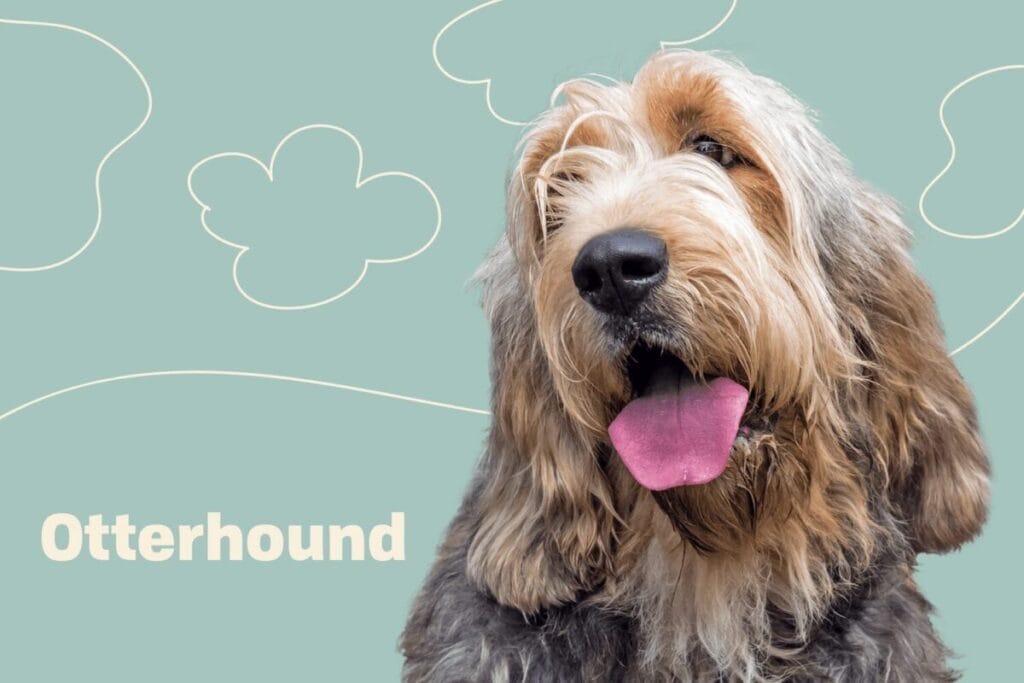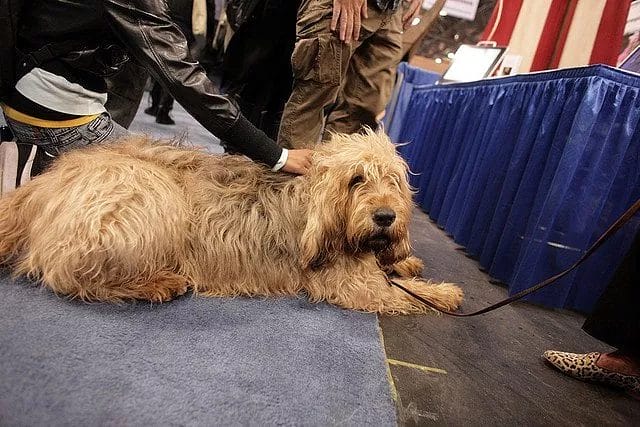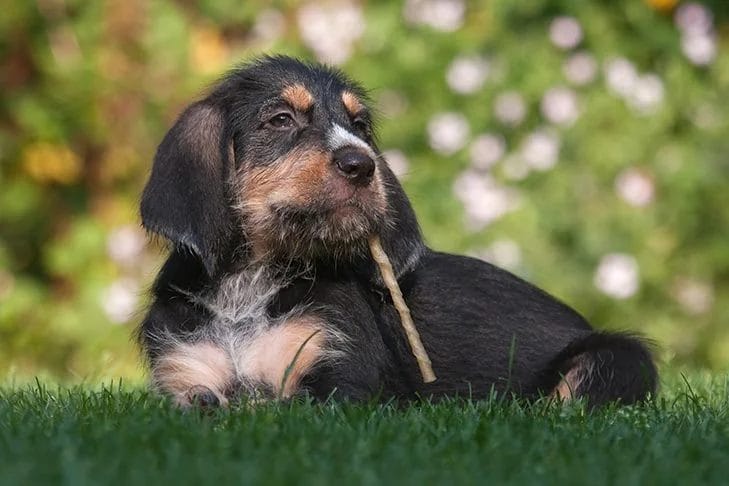The Otterhound Dog Breed is a truly remarkable breed, prized for its unwavering determination in tracking and its gentle, affectionate temperament with loved ones.
Introduction The Otterhound Dog Breed
Originating from England, the Otterhound is an ancient breed that was developed specifically for hunting and tracking otters along riverbanks and marshlands. These dogs possess an exceptional sense of smell, webbed feet, and a sturdy, muscular build that allows them to navigate challenging terrains and waterways with ease. Despite their formidable hunting abilities, Otterhounds are known for their gentle, loyal, and affectionate nature, making them beloved companions.

Adaptability: ⭐️⭐️⭐️
Adapts Well to Apartment Living: ⭐️
Good for Novice Owners: ⭐️⭐️
Sensitivity Level: ⭐️⭐️⭐️⭐️
Tolerates Being Alone: ⭐️⭐️⭐️
Tolerates Cold Weather: ⭐️⭐️⭐️⭐️⭐️
Tolerates Hot Weather: ⭐️⭐️⭐️
All-around friendliness: ⭐️⭐️⭐️⭐️
Affectionate with Family: ⭐️⭐️⭐️⭐️⭐️
Kid-Friendly: ⭐️⭐️⭐️⭐️
Dog Friendly: ⭐️⭐️⭐️⭐️
Friendly Toward Strangers: ⭐️⭐️⭐️
Health and Grooming Needs: ⭐️⭐️⭐️⭐️
Amount of Shedding: ⭐️⭐️⭐️⭐️
Drooling Potential: ⭐️⭐️⭐️
Easy to Groom: ⭐️⭐️⭐️
General Health: ⭐️⭐️⭐️⭐️
Potential for Weight Gain: ⭐️⭐️⭐️
Size: ⭐️⭐️⭐️⭐️
Trainability: ⭐️⭐️⭐️
Easy to Train: ⭐️⭐️⭐️
Intelligence: ⭐️⭐️⭐️⭐️
Potential for Mouthiness: ⭐️⭐️⭐️⭐️
Prey Drive: ⭐️⭐️⭐️⭐️⭐️
Tendency to Bark or Howl: ⭐️⭐️⭐️⭐️
Wanderlust Potential: ⭐️⭐️⭐️⭐️⭐️
Exercise Needs: ⭐️⭐️⭐️⭐️⭐️
Energy Level: ⭐️⭐️⭐️⭐️⭐️
Intensity: ⭐️⭐️⭐️⭐️
Exercise Needs: ⭐️⭐️⭐️⭐️⭐️
Potential for Playfulness: ⭐️⭐️⭐️⭐️
- Appearance: The Otterhound is a large, rough-coated breed with a distinctive shaggy appearance. They have a strong, muscular build, webbed feet, and a long, tapered tail. Their expressive faces feature floppy ears and a warm, friendly expression.
- Characteristics: Known for their exceptional scenting abilities, endurance, and determination, Otterhounds were bred for the challenging task of hunting otters. They are intelligent, affectionate, and possess a strong prey drive.
- Popularity: The Otterhound is considered a rare breed, with relatively low numbers worldwide, making them a unique and sought-after companion for those seeking a loyal and devoted hunting or tracking dog.
- Temperament: Otterhounds are gentle, loyal, and affectionate with their families, but can be reserved around strangers. They possess a strong prey drive and can be tenacious in their pursuit of scents or quarry.
- Lifespan: The average lifespan of a healthy Otterhound is 10-13 years.
- Coat Color: The most common coat colors for Otterhounds are various shades of brown, ranging from wheaten to grizzle.
The Otterhound is considered an ancient, distinct breed that originated in England and was developed specifically for hunting otters along riverbanks and marshlands.
How to Take Care of an Otterhound Dog Breed
Food:
- High-quality, protein-rich dog food is essential for the Otterhound’s large size and active lifestyle, providing the necessary nutrients for growth, maintenance, and energy.
- Consider incorporating raw or fresh ingredients, such as lean meats, fish, and vegetables, to support the Otterhound’s overall health and wellness. Example 3: Provide ample access to fresh, clean water at all times, as these active dogs can become dehydrated, especially during strenuous activities or in warm weather.
Environment:
- Otterhounds thrive in spacious environments with ample room to roam and exercise, such as large yards, farms, or rural settings.
- Secure fencing or a contained area is crucial, as the Otterhound’s strong prey drive and wanderlust may lead them to pursue scents or quarry over long distances. Example 3: Provide access to water sources, such as ponds or streams, as these dogs enjoy swimming and may seek out opportunities to indulge their natural instincts.

Take Care Method: Positive reinforcement training techniques, combined with patience, consistency, and early socialization, are essential for shaping the Otterhound’s behavior and fostering a strong bond with their owners. Providing ample mental and physical stimulation through activities like tracking or scent work can help satisfy their natural instincts.
Grooming: The Otterhound has a dense, rough, and weather-resistant double coat that requires regular grooming to maintain its appearance and prevent matting. Weekly brushing with a slicker brush or metal comb is recommended to remove loose hair and debris. Bathing should be done as needed, typically every 6-8 weeks or when visibly dirty. Regularly check and trim their nails, and keep their ears clean and dry to prevent infections.
How to Prepare for an Otterhound’s Life
Provide a secure, spacious environment, ample exercise, and mental stimulation for a well-adjusted and happy Otterhound.
When preparing for an Otterhound, ensure you have a high-quality diet, a securely fenced area for exercise and exploration, sturdy toys, and access to water sources if possible.
Essential equipment for caring for an Otterhound includes a sturdy leash and collar or harness, a crate or indoor kennel, grooming tools (brushes, combs, nail trimmers, ear cleaner), and interactive toys for mental stimulation.
Common diseases in Otterhounds include hip and elbow dysplasia, bloat (gastric dilatation-volvulus), and certain types of cancers. Regular veterinary check-ups, appropriate exercise, and a balanced diet can help prevent or manage these conditions. Medications like glucosamine supplements and anti-inflammatory drugs may be prescribed for joint issues.
Necessary vaccines for Otterhounds include rabies, distemper, parvovirus, and canine influenza, as recommended by your veterinarian based on your dog’s age, lifestyle, and risk factors.
How to Buy/Adopt an Otterhound
Locations of Otterhound’s Popularity: The Otterhound breed is most popular in its native England, as well as other parts of Europe and North America, particularly among hunters, trackers, and those seeking a unique and loyal companion.
Average Price for an Otterhound: The average price for an Otterhound puppy from a reputable breeder can range from $1,000 to $2,000, depending on the location, pedigree, and overall quality of the breeding program.
Communities for Otterhound Adoption:
- Facebook: Otterhound Rescue & Rehoming (USA), Otterhound Adoption (UK)
- Instagram: @otterhoundrescue, @adoptanotterhound
- Twitter: @OtterhoundRescueUS, @OtterhoundAdoptUK
What to Check Before Adopting/Buying an Otterhound:
- General Health: Ensure the puppy or dog appears healthy, with clear eyes, a clean coat, and no signs of illness or distress.
- Vaccination Status: Ask for documentation of up-to-date vaccinations and deworming treatments.
- Medical History: Request medical records, including any prior health issues or treatments, to ensure transparency and make an informed decision.
- Otterhound Rescue Groups: United States: American Otterhound Rescue Association (AORA), Otterhound Rescue Network United Kingdom: Otterhound Rescue UK, Otterhound Rehoming Trust Canada: Canadian Otterhound Rescue (COR), Otterhound Adoption Alliance

Common Names for Otterhounds
When naming an Otterhound, consider their hunting heritage, distinctive appearance, or affectionate nature.
Popular names for Otterhounds include Bear, Daisy, Finn, Izzy, Milly, Otter, and Willow.
“How to stop Otterhound Dogs from biting?”
Provide ample exercise, mental stimulation, and positive reinforcement training to redirect their natural prey drive and discourage biting behavior.
“How to do socialization and raise a friendly Otterhound Dogs?”
Early socialization and positive reinforcement training from a young age can help Otterhounds become well-adjusted and friendly with people and other animals.
“How to train your Otterhound Dogs?”
Otterhounds respond well to positive reinforcement training methods, such as reward-based techniques, leveraging their intelligence and food motivation. Consistency and patience are key.
“How long should we check Otterhound Dogs health with a vet?”
Regular annual check-ups with a veterinarian are recommended for Otterhounds, along with appropriate vaccinations and preventive care.
“Are Otterhound Dogs good family pets?”
With proper socialization and training, Otterhounds can make excellent family companions, as they are gentle, affectionate, and loyal with their loved ones.
“Are Otterhound Dogs good with children?”
Otterhounds are generally good with children, especially those they have been raised with, but close supervision is recommended due to their large size and boisterous nature.
“Are Otterhound Dogs good with other animals?”
Early socialization and proper introductions can help Otterhounds coexist with other pets, but their strong prey drive may pose challenges with smaller animals or wildlife.
“Is an Otterhound Dogs a smart dog?”
Yes, Otterhounds are considered intelligent dogs and can be trained to perform various tasks and commands with patience and consistency.
“What is the temperament of an Otterhound Dogs?”
Otterhounds are gentle, loyal, and affectionate with their families, but can be reserved around strangers. They possess a strong prey drive and determination.
“How many types of Otterhound Dogs are there?”
The Otterhound is considered a distinct breed that originated in England and was developed specifically for hunting otters along riverbanks and marshlands.
“How many coat colors do Otterhound Dogs have?”
The most common coat colors for Otterhounds are various shades of brown, ranging from wheaten to grizzle.
“How long can an Otterhound Dogs live?”
The average lifespan of a healthy Otterhound is 10-13 years.
“Can Otterhound Dogs cause allergies?”
Like most breeds, Otterhounds can potentially trigger allergies in some individuals due to their dander and saliva, but their coats are relatively low-shedding compared to some other breeds.
“Are Otterhound Dogs ferocious?”
While Otterhounds are tenacious in their pursuit of scents or quarry, they are not inherently aggressive or ferocious when properly socialized and trained.
“Do Otterhound Dogs have much hair loss problems?”
Otterhounds have a dense, weather-resistant double coat that sheds moderately throughout the year, but excessive hair loss can be a sign of underlying health issues and should be addressed by a veterinarian.
By following our website, you can find the perfect dog breeds for you and provide them with the best possible dog care. Remember that owning a dog is a lifelong commitment that requires time, money, and patience. But it is also a rewarding experience that will bring you joy and companionship. All information in Dog care tips.

